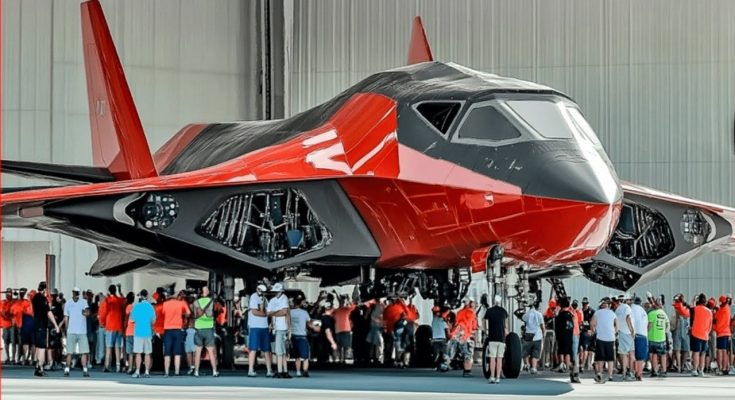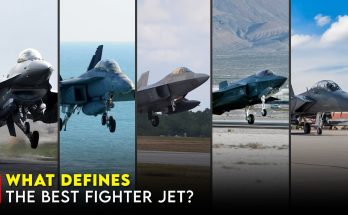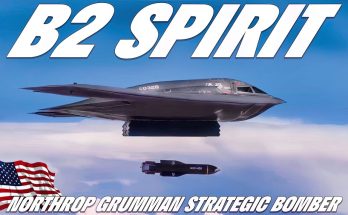In a stunning announcement that has left the global defense community in awe, the United States has revealed its first sixth-generation fighter jet, the Next Generation Air Dominance (NGAD). This cutting-edge aircraft represents the future of aerial combat and is poised to secure the U.S. military’s superiority in the skies for decades to come. With its groundbreaking features, the NGAD has shocked the world, pushing the boundaries of what was previously thought possible in air warfare technology.
A Leap Forward in Technology
The NGAD is a highly advanced fighter aircraft designed to outclass current fifth-generation fighters such as the F-35 Lightning II and F-22 Raptor. Developed by the U.S. Air Force, the NGAD incorporates cutting-edge technologies that combine speed, stealth, artificial intelligence (AI), and hypersonic weapons, making it a game-changer for future aerial combat.
Key Features of the NGAD
- Stealth and Low Radar Signature: One of the most striking features of the NGAD is its advanced stealth capabilities. Designed to be virtually invisible to enemy radar, the NGAD is capable of penetrating even the most sophisticated air defense systems. Its unique shape and materials further reduce its radar cross-section, making it an elusive target.
- Artificial Intelligence Integration: The NGAD is equipped with state-of-the-art AI systems that allow it to process vast amounts of data in real-time. This capability enhances situational awareness, allowing the pilot to make quicker decisions based on comprehensive intelligence gathered from both manned and unmanned assets. The AI can also manage certain combat tasks autonomously, offering a greater advantage in high-stress, high-speed environments.
- Hypersonic Weaponry: In a major leap forward, the NGAD is designed to carry hypersonic weapons, capable of traveling at speeds greater than five times the speed of sound. This allows the aircraft to engage targets at unprecedented speeds, making it harder for adversaries to intercept or counter. With hypersonic capabilities, the NGAD can strike high-value targets from extreme distances with incredible precision.
- Unmanned Operations: Unlike its predecessors, the NGAD is designed to operate seamlessly with unmanned aerial vehicles (UAVs). This “manned-unmanned teaming” concept allows the NGAD to coordinate with drones to extend its range, enhance targeting precision, and offer unparalleled flexibility in combat scenarios. The aircraft can even operate autonomously in certain missions, increasing its versatility.
- Enhanced Connectivity: The NGAD is part of a networked force, with the ability to communicate and coordinate with other aircraft, ground stations, and naval assets. This connected approach enables the NGAD to function as a force multiplier, working in tandem with a range of platforms to complete complex missions in real-time.
Shocking the World
The unveiling of the NGAD has not only impressed military experts but has also caught rival nations off guard. The aircraft’s advanced stealth, AI, and hypersonic capabilities place it far ahead of any other fighter jet currently in development, including those being created by China and Russia. As global military powers race to develop their own sixth-generation aircraft, the United States’ early success with the NGAD sets a new benchmark in air combat technology.
Experts have stated that the NGAD’s capabilities would provide the U.S. Air Force with an unmatched advantage in future conflicts. The combination of speed, stealth, AI, and precision strikes represents a significant leap forward in both offensive and defensive strategies. Its ability to operate alongside unmanned systems further enhances its flexibility, making it an invaluable asset in modern warfare.
The Strategic Impact
The development of the NGAD marks a key turning point in the ongoing arms race for next-generation military technologies. As other countries like China and Russia ramp up their own sixth-generation aircraft programs, the U.S. is making clear that it intends to remain the leader in air superiority. The NGAD is not just a fighter jet; it is a symbol of the future of warfare, where technology, innovation, and connectivity will define the outcome of battles.
The shockwaves caused by the NGAD’s unveiling will undoubtedly have lasting implications on defense strategies worldwide. The U.S. Air Force’s ability to integrate AI, hypersonic weapons, and unmanned platforms into a single system gives it a significant edge over potential adversaries. As the world watches with bated breath, the NGAD sets the stage for the next generation of aerial warfare.



